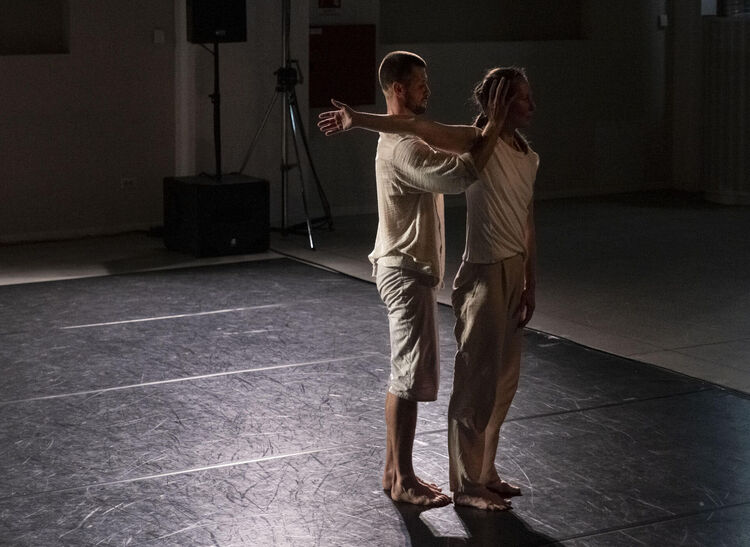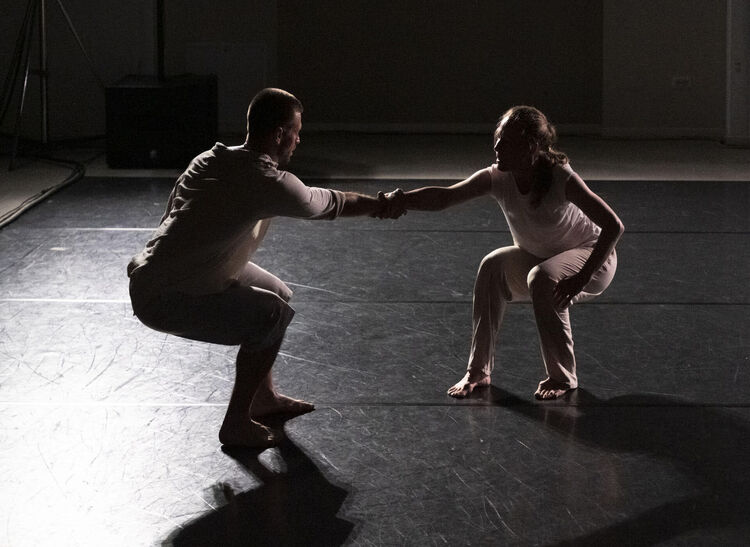Zarhy’s Affect: Beyond the Binary of Ausencia and Presencia
Choreographer May Zarhy’s double bill directly tackles the theme of the 36th edition of Festival Danza Estate in Bergamo, Italy, which interrogates the roles presence and absence play in building spaces and relations in our time. With Ausencia and Presencia, Zarhy and her remarkable dancers move beyond the traditional epistemic opposition of the two terms for a new affective experience of these key concepts in performance and contemporaneity.
The beautiful cultural and social center “Daste” is a repurposed former hydroelectric power plant in the periphery of Bergamo, in the heart of northern Italy. At the entrance, in an expansive courtyard, a giant, bronze engine memorializes the area’s industrial development in the first half of the twentieth century. Entering the performance space, with white walls, large rose windows and glass doors, is an immersion in the brightness of an early summer evening. For Ausencia, the audience seats along two sides of the black marley floor – a simple choice with which choreographer May Zarhy marks the performative dispositive while unsettling expectations about theatricality. Based in Berlin, Zarhy studied choreography at the Rotterdam Dance Academy. Upon graduation, she assisted William Forsythe during the creation of Three Atmospheric Studies and started the collective MAMAZA. I have followed Zarhy’s choreographic, interdisciplinary, theatrical, site-specific, and curatorial projects for about ten years. I welcomed with anticipation Festival Danza Estate’s choice to shed light on a remarkable independent dance artist, whose work, I believe, constantly questions the liminal spaces of choreography and performance.
Renegotiating presence
Keren Lurie Pardes enters the performance space with a stealthy walk, a discreet presence, dressed all in black. Her bare feet and arms punctuate the dark floor. Ausencia is a duet with one body on stage, developed during the pandemic with two dancers and conceived to be performed by one only. Lurie Pardes is listening, researching, and partnering with an invisible body that sometimes seems to move unpredictably, challenging her body in vertiginous spirals, while carefully devising solutions to move (together). Her fluctuating rhythms, her trust in abandoning herself towards the floor, as if supported, in a precise, purposeful, and intense flow of movement without hesitation (except for some occasional micro contractions of the face muscles) create something which I can only describe as somatic density.
In this new sense of space, it becomes palpable that the invisible partner, as the etymology of “absence” suggests, is “away from,” is someone that plays with distance, claiming attention and listening – which Lurie Pardes masterfully practices. Ausencia becomes a renegotiation of the presence of the visible. Closer to the end, Lurie Pardes moves towards the audience, summoning us with her sea-deep gaze, gestures and proximity. The program of the performance states that the absence of the other dancer “creates a negative space”, which might have been the epochal affect of the pandemic time. However, for me, the materiality of movement, never frantic yet breathtaking, generates an enhanced sense of presence, even for the partner that is not there (yet or ever). Ultimately, Lurie Pardes’s remarkable rigor, concentration, and precision are a praxis of generous commitment, a resistive homage to the irreducibility of presence.
A sudden vibrancy
After a one-hour break, as dusk sets, only the glare of the lampposts reverberates in the Daste performance space. For Presencia, the audience set up changes. Now all the seats are on one side, and such frontality is programmatic. To be “present” is indeed “to be before someone,” to manifest yourself to another in reciprocal and bare wholeness, as the two dancers (both in physical presence) in Presencia do to each other through an ongoing superposition of gestures, movements, sensations, and affects as a shared praxis of memory.

Dominic Santia inhabits the space with unique gravitas. His first movements seem a recollection of experienced gestures, of traced paths through which he moves every single joint with quiet and articulated precision. Brit Rodemund materializes on stage with the enigmatic and malleable aura of a Tilda Swinton. In her uncanny grace, Rodemund seems to remind us of the thin line – or the space of attrition – that separates (and baffles) presence and absence. And it is in Presencia that I strongly feel that the question of the invisible, of the ghost, of the fantasmata is at stake. One of the key issues in dance (and dance studies) dates to a seminal, fifteen-century treatise by Domenico da Piacenza, in which the ballet master questions what happens in that moment of suspension between two movements, that moment that contains the memory of the past and the anticipation of the future.
As Ausencia was a duet in the appearance of a solo, Presencia seems a duet that progressively expands towards a proliferating sense of multiplicity. Santia and Rodemund move differently and in correspondence, playing with reciprocal delay and/or anticipation: their encounter is always a felicitous negotiation. In their temporal discrepancies, their bodies meet in asymmetrical yet balanced positions. But the leading leitmotiv in Presencia is the process through which these recurring positions – almost tableaux vivants – come to be, always slightly different, through variations, adjustments, shifts, and diversions that manifest the performers’ ongoing decision-making and tuning process. The experience of the dancers as choreographing subjects is at the core of Zarhy’s work, and, in Presencia, it surely shows the beauty that persevering in reciprocity generates. What strikes me, at some point, is the realization of a new spatial density, the sudden openness and vibrancy of the space, so much so that, despite being captured by the performers, I have to look around and make sure that the performance space isn’t actually physically expanding. I realize that this spatial impression is the affective force of the accumulation of Rodemund’s and Santia’s experience, labor, and decisions of being in relation.

The material affect of presence
In Ausencia and Presencia, Zarhy’s choice of working with highly technical and skilled dancers reveals her capacity to choreographically subtract virtuosity from the performance of doing (for impressing, for entertaining, and so on) to recraft a different sense of time, to suspend and be-with, to recalibrate our attention to get in tune with an interlocutor. In these works, we see the labor that the dancers’ commitment to listening and being-fully-with requires. For instance, about twenty-five minutes into Presencia, we realize how the sweat is building up, how the unspectacular yet intricate and virtuosic solo and partnering movements are soaking the costumes, how the heat of the bodies designs its own choreography of drops along the dancers’ skin.
A special note goes to Daniella Ljungsberg’s soundscape in both pieces, whose vibrancy, adventurous layers and effects palpably enhanced the three dancers’ focus and energy, generating a warm yet haunting feeling.
Ultimately, Ausencia and Presencia, in their independent and intertwining movement, show that there’s no “inch of time” (a lapsus of Zarhy during our conversation) or “moment of space” to which we can be inconsequentially neutral or indifferent in our relationality. Moving beyond the traditional epistemic binaries (absence vs. presence, tangible vs. ephemeral), in her choreographic practice Zarhy reframes some of the conceptual pillars of dance, performance, and everyday life.
Written from the Italian premiere within Festival Danza Estate, on June 20, 2024, at Daste – Spazio eventi, Bergamo, Italy.
Ausencia
Choreography: May Zarhy
Performance: Keren Lurie Pardes (Original Cast: Ariel Gelbart)
Created with dancers: Moran Muller, Ariel Gelbart
Music: Daniella Ljungsberg
Distribution: Fauves – Agency for the Performing Arts (Léa Chalmont + Julia Danila)
World premiere: February 20, 2021
Presencia
Choreography: May Zarhy
In collaboration with dancers: Brit Rodemund, Dominic Santia
Music: Daniella Ljungsberg
External eye: Moran Muller, Ariel Gelbart
Light design: Rotem Elroy
Costumes: Vivi Ben Ezra
Research assistant: Nitsan Margaliot
Pantomime coaching: Katja Tannert
Costume consultant: Claudia Hill
Production: Dino Spiri
Distribution: Fauves – Agency for the Performing Arts (Léa Chalmont + Julia Danila)
World premiere: February 8, 2023



